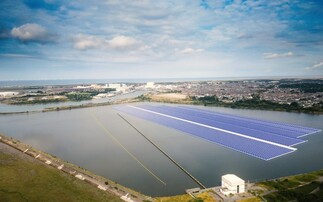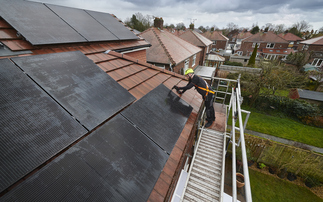SolarAid chairman Jeremy Leggett writes about the three days he spent with the SunnyMoney team in Kenya and Zambia
Day one - Kenya
A crack-of-dawn flight from Nairobi, west to Eldoret. A SunnyMoney field team of three meets me at the airport, and we drive in a van nearly two hours further west, to Bungoma, a market town near the border with Uganda. Along the way, greenery; fields of maize, cropped; sugarcane, uncropped. This is the breadbasket of Kenya.
We fill the van with freshly-delivered boxes of solar lights. Thirty boxes, ten lights apiece. I do a rough calculation. We have sold 500,000 in the last six months, across our four countries of operation. That¹s 1,600 loads like this.
En route we passed the oil refinery that serves this region, dozens of tankers in a queue stretching away from it, sprawling along the roadsides, waiting to be filled with the derivatives of crude oil delivered by pipeline from Mombasa. Further along the road to Uganda we turn right, and drive five bouncing miles down a red earth road, spewing dust behind us. We pass a school, seemingly miles from the nearest village, yet with several hundred shool kids running around in identical green uniforms in a spacious dirt schoolyard.
How do they get to school, I ask Victor, team leader."They mostly walk", he says. "Most of them many kilometres, starting off in the dark".
There are more than 120 schools like this just in the district we are in, Bumula. We come to a small town that gives the region its name. We park in a yard outside the Education Commissioner's office. Eighty headmasters and headmistresses are gathered there in a meeting room.
This is our main route to market: via the education authorities, through the schools.
Victor has clearly done this many times before. He walks the headteachers through three types of solar light: their benefits, their prices, how they can be ordered. He is a born salesman, working his audience a bit like a revivalist preacher. The head-teachers respond good naturedly. He jokes that once they taught him, and now look, he is teaching them. I hear a lot of laughter this morning.
"And what is it called?" he asks.
"A Sun King Eco," they chant.
"And what does it cost?"
"A thousand shillings."
"And what does kerosene cost on average each year?"
"Five thousand shillings."
"Are we together on this?"
"Yes," they shout.
Day two - Kenya
We drive two hours northeast of Eldoret, most of it crawling 30 km down a rutted red dirt road into low hills. The windows are up, but it is impossible to keep the dust out. My nose begins to clog. The dust smears make the land cruiser look as though it is rusting away.
We come to a village called Cheptongwe, two ranks of ramshackle concrete, mud brick, wood and corrugated iron buildings along the red road. Picturesque slopes of woodland and maize field rise on either side. At the far end of the village, we pull into a grass yard in front of a no less ramshackle building.
This is the headquarters of the Chebiemit Division of the Kenyan Ministry of Education. Here we will deliver solar lights to headmasters and headmistresses who have placed earlier orders via the SunnyMoney call centre.
All around me, amid the poverty, I see evidence of how seriously education is taken: how hard people are trying, amid the poverty. Head teachers begin to arrive. Hudson of SunnyMoney distributes boxes and bags of solar lights from the open back doors of the land cruiser. A third of the heads have already paid, via M-pesa. Others bring cash. Jamie, a funder travelling with us, disappears for a while, and reappears with a crate of Coca-Cola bottles, purchased from a concrete shack across the road. He disperses bottles to pleased headteachers as they queue. The logo-emblazened red plastic box is soon empty.
I look at it reflectively. Coca-Cola was the first company to crackdistribution channels to a mass market in Africa. I have been trying to entice the giant corporation into some kind of partnership with SolarAid and SunnyMoney for a while now. The deal, as I pitch it, would be that they give us access to their channels, and we give them brand value-added because of the social good we can do with solar lighting. No luck yet, but I continue to live in hope, and send occasional missives to Coca-Cola headquarters in Atlanta telling them as modestly as I can all about our progress.
Day three- Zambia
Three hours out of Lusaka, along arrow-straight tarmac roads, Zambian Ops Director Sarah Bentley and I join a team of three SunnyMoney staff doing market research prior to a sales campaign. We have lunch with them: stodgy white balls of ground-and-boiled maize and rubber-tough chicken. Washed down with Coca-Cola, of course.
I get to know them a little. They are all in their early twenties, not long out of university.Elizabeth Lwele, team leader, is from the Copper Belt. Blessings and Muyembe are fromLusaka. Each was picked from hundreds of applicants for their jobs. They are softly spoken and full of smiles, yet ooze enthusiasm for their work. They explain their mission. Each day they each interview twenty ordinary citizens on the streets and in the markets, and five traders dealing in electrical goods.
The questionnaire they use runs to 39 questions, covering every aspect of the interviewee's consumption and spending, circumstances and preferences. They will do this for ten days. I ask if anyone refuses to be interviewed. Rather the reverse, they say. People come up to them asking if they will be interviewed too.
Once the campaign starts, it will be nothing if not rooted in data, I observe. The sales targets will have some meaning. Already patterns are becoming clear to them they say. For example, kerosene is not the competition here. It is cheap lanterns driven by non-rechargeable batteries.
Many market stalls sell these. And the economics are horrific. People spend a small fortune on batteries. The payback on a solar light can be measured in weeks. Yet we see very few solar lights. On a long walk through the bustling market after lunch, I see none. I imagine this scene in countless towns all over Africa, all over the developing world.
We are going to change this.
This article is part of the BusinessGreen Solar Hub, hosted in partnership with Solar Aid. You can read Jeremy's full Kenya diaries at the Solar Aid website.








